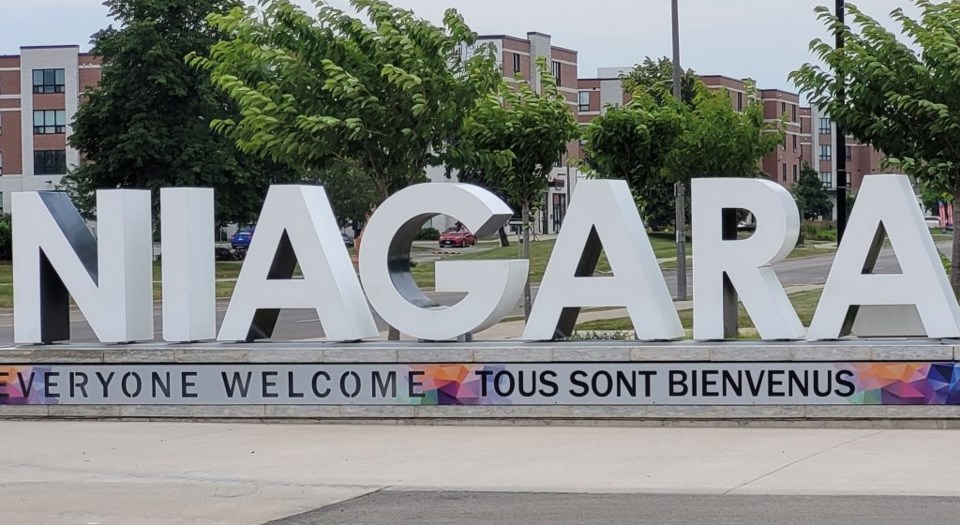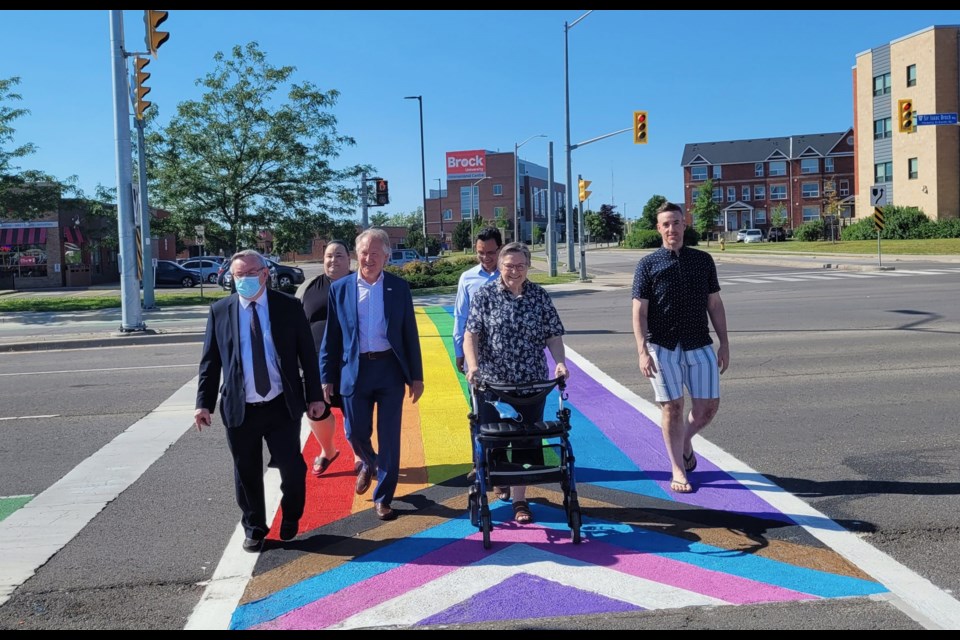As Pride Month wraps up, it does so with the addition of a Pride crosswalk installed by the Niagara Region.
And while the rainbowl crosswalk covers a wide range of diverse groups, including the 2SLGBTQQIA+ community in Niagara and beyond, Enzo De Divitiis, chair of Pride Niagara, stressed at the unveiling the need for “supporting everyone, and being an ally to everyone. You can’t support this group, and not that group, or support them this month, but not next month,” he said.
There was much joking about the crosswalk being in Thorold — Thorold Mayor Terry Ugulini spoke of how proud he was to have it in his municipality, while Regional Chair Jim Bradley emphasized it’s in Niagara Region. However it connects to St. Catharines, and is intended to be a symbol of welcoming and inclusivity across the region, Bradley said.
“We are proud of this initiative and want to thank all the parties involved in making this happen,” said Ugulini. “The City of Thorold is committed to supporting its 2SLGBTQQIA+ community and is dedicated to being a responsive city that respects the rights, differences, and dignity of all its people. This new crosswalk shows our commitment to foster a community where every person feels like they belong,” he said.
It was completed last Tuesday, and officially recognized Friday, as traffic passed by and over it at the intersection of Sir Issac Brock Way, and the Schmon Parkway.
It’s a busy and highly visible location, much travelled by regional staff, and Brock staff and students, with regional buildings on one side of the intersection, Brock University buildings on the other, and student residences on both sides, as well as a Tim Hortons and McDonald’s side by side.
The design of the Pride crosswalk was developed by the Brock University Human Rights and Equity office, in collaboration with the local 2SLGBTQQIA+ communities, “showing our commitment to diversity and inclusion in Niagara,” Bradley told a small crowd gathered for the event.
“Throughout the month of June and beyond, Niagara will continue to promote, educate and drive awareness to benefit local 2SLGBTQQIA+ communities within Niagara,” he said. “Our goal is to foster a community where every person feels they belong.”
The all-inclusive colours of the crosswalk, intended to represent the safety and support of all the communities who walk on it, include black and brown stripes as well as light blue, pink, and white.
“The black and brown represent 2SLGBTQQIA+ community members who are racialized, and have historically and continue to experience marginalization within our communities; the light blue, pink, and white represent transgender community members; finally, the last purple chevron intersects with the white as a reminder of the two-row wampum agreement. These colours represent the Indigenous land we walk on and our responsibility to the land and to each other,” a regional press release explained.
“We will continue to promote, educate and drive awareness of gender and sexually diverse individuals in our community as part of our efforts to build the most inclusive community possible,” said Bradley.
Speakers representing Pride Niagara and Senior Pride Niagara Network expressed gratitude for the support the crosswalk represents. They explained the importance of having a visible symbol of inclusivity, and how much has changed as such symbols become more and more common.
In his 12 years with Pride Niagara, all volunteer based, De Divitiis said it’s been an effort over the years just to get municipalities to raise rainbow flags during Pride Month. There was a time if Pride Niagara wanted to attract vendors at an event, they had to pick odd days to hold the event, he said, and pay the vendors to come. “Things have drastically changed. We have these positive spaces, safe places,” but, he explained, “nobody else can identify these spaces. You have to know what a safe space is for yourself.”
The crosswalk is a reminder of support, he said, a beacon to show everyone is supported and celebrated.
“I can’t wait to see every municipality follow suit.”
Representing the Senior Pride Niagara Network, for those 55 and over, Nancy Radclyffe said she feels her group has strong support from “a great group of allies.” But it’s taken a while to get there, she added.
“For 50 years we’ve been fighting this battle. We’re talking about the same things now we’ve been talking about for 50 years.”
She’s expanding the battle now to reach more people who deal with seniors, including care-givers and staff in long-term care homes.
About the crosswalk, she said, “you don’t know how much this means, how it makes us stand up stronger and say yes, this is about us. Today we celebrate our successes. Today we celebrate how far we’ve come.”
Sabrina Constance-Hill, chair of the Niagara Region Diversity, Equity, and Inclusion Advisory Committee, spoke of her identity struggles as a teenager, being dismissed, told she was confused, she was wrong, “and finding few allies, and fewer places to turn to.” Today, there are places in the community where support exists, she said, referring to the crosswalk “as a symbol of acceptance, pride, hope and opportunity.”
Ken Chan, vice-president of administration at Brock University, comes from a country where it’s still illegal to be in a same-sex relationship, and told those gathered at the Pride crosswalk that he came out despite the law. He’s proud to be at Brock University, “where we’re supported in many ways,” he said, and in the Niagara Region, “where everyone is welcome.”
The crosswalk, he said, “sends a very strong message that you are safe here.”

